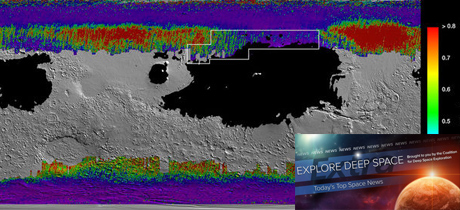In Today’s Deep Space Extra… NASA and Boeing are negotiating terms of future Space Launch System (SLS) core stage rocket production. A NASA Jet Propulsion Laboratory (JPL) study zeros in on subsurface water ice deposits on Mars. Blue Origin’s New Shepard family of suborbital rockets launches for a 12th time.
Human Space Exploration
NASA and Boeing look ahead to long-term SLS production
Coalition Member in the News – Boeing
SpaceNews.com (12/11): NASA and Boeing are engaged in contract discussions for the long term production of Space Launch System (SLS) first stage cores. NASA Administrator Jim Bridenstine declared assembly complete for the first of the 212 foot long rocket stages as the Michoud Assembly Facility in New Orleans earlier this week. At the December 9 event Bridenstine predicted the cost of the SLS core would decline as more of the rockets are produced. The assembly of a third and fourth and possibly up to 10 of the SLS cores is under discussion. The SLS will launch Artemis missions with Orion crew capsule carrying astronauts bound for the Moon. Artemis 3, the first landing with female and male astronauts is planned for 2024.
NASA’s treasure map for water ice on Mars
NASA/Jet Propulsion Laboratory (12/10): Using data from NASA’s Mars Reconnaissance Orbiter and Mars Odyssey spacecraft, the agency has compiled a new map of subsurface water ice deposits on the red planet that could help to select landing sites for future human exploration. The ice deposits in the Mars northern hemisphere are believed to be as close as an inch below the surface, and a potential resource for water and the production of liquid hydrogen and oxygen rocket fuels. Findings were published in the journal Geophysical Research Letters.
Space Science
NASA to buy more commercial Earth observation data
SpaceNews.com (12/11): NASA plans to continue and expand the purchase of commercial Earth satellite observation data, following a successful trial period to assess the quality and utility of data obtained from Maxar and Planet satellites, according to a presentation before the American Geophysical Union fall conference underway in San Francisco this week. NASA’s Commercial Smallsat Data Acquisition program will seek additional vendors, while it works through licensing provisions.
Blue Origin’s New Shepard makes record 6th launch to fly NASA science, student art to space
Space.com (12/6): A Blue Origin New Shepard reusable suborbital launch vehicle flew for a sixth time on Wednesday, with a payload that included NASA experiments and thousands of postcards from a child engagement initiative. It was the 12th launch of a New Shepard spacecraft overall. After a liftoff from West Texas delayed by fog, the New Shepard took flight at 12:53 p.m., EST, rising to an altitude of 65 miles before a return. As development continues, Blue Origin is looking to launch its first human passengers in 2020.
We know we are made of star dust. But did it come from red giants?
Universe Today (12/11): The stardust that comprises everything in our solar system came primarily from aging red giant stars, according to a study focused on isotopic ratios led by Swiss scientists and published this week in the journal Nature Astronomy.
Other News
India’s 50th PSLV lifts off with satellites from five nations
Spaceflightnow.com (12/11): Ten spacecraft from five nations were launched Wednesday atop an Indian Polar Satellite Launch Vehicle (PSLV). It was India’s final planned launch of 2019. Among them was an Indian radar surveillance satellite.
Venus and Saturn meet in the sunset sky
Spaceweather.com (12/11): Look to the south and west at sunset to gaze up at bright Venus and Saturn, and with a small telescope Saturn’s rings are visible.

